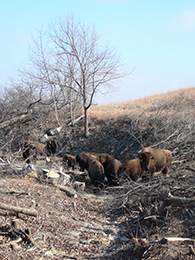K-State scientists publish long-term research about woody vegetation and grassland ecology
MANHATTAN — New research from a team of Kansas State University scientists links increased woody vegetation to declining stream quality in grasslands.
"Trajectories and state changes of a grassland stream and riparian zone after a decade of woody vegetation removal" has been published in Ecological Applications, the applied journal of the Ecological Society of America. It covers 10 years of research conducted at the Konza Prairie Biological Station.
"We were interested in finding out how the shift from grassy stream banks to woody vegetation influenced water quality, water quantity and stream ecology," said Walter Dodds, university distinguished professor of biology.
Dodds is part of a research team with K-State biologists Jesse Nippert and Zak Ratajczak, doctoral student Rachel Keen and research assistants Amanda Kuhl and Jeffery Taylor. Geographer Bartosz Grudzinski, Miami University, and biologist Allison Veach, University of Texas at San Antonio, are also part of the team.
They began by cutting woody vegetation within 90 feet of the stream channel in a watershed on the Konza Prairie. The team re-cut the woody vegetation every two years during a 10-year span and burned the watershed every other spring.
While shrubs re-sprouted and replaced the trees, prairie vegetation did not come back into the removal areas. Even areas seeded with native prairie species did not revert to grasslands. The results suggest that controlling woody vegetation along stream channels in this area will require more aggressive measures than cutting and burning every two years.
"The work illustrates that we are living in a changing world and that much of our understanding of natural systems based on past patterns may not be transferable to predictions of future ecosystem behaviors," said Dodds.
The expansion of woody vegetation reduces cattle forage in pastures and decreases water yield from streams in areas where the vegetation is expanding. This project illustrates continued declining water yields after stream-adjacent trees were gone for a decade.
"Sustainable water resources are key to our natural environment and the Kansas economy," said Nippert. "This research clearly shows the negative consequences of woody plant expansion in Kansas grasslands and rangelands. There are no quick fixes once the woody plants have established."

